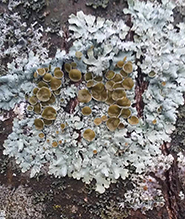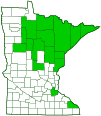Bottlebrush Shield Lichen
(Parmelia squarrosa)
Conservation • Description • Ecology • Distribution • Taxonomy
Conservation Status |
|
|||||||
| IUCN Red List | LC - Least Concern |
|||||||
| NatureServe | NNR - Unranked |
|||||||
| Minnesota | not listed |
|||||||
Description |
||
Bottlebrush Shield Lichen is a common, widespread, typical shield lichen. It occurs in Europe, Asia, and North America. In the United States, it occurs in the east from Maine to New Jersey, west to Ohio and Minnesota, and south along the Appalachian Mountains to northern Georgia. It also occurs on the West Coast from northern Washington to central California. In Minnesota it is relatively common in the northeast and north-central regions, but it is mostly absent from the remainder of the state. Bottlebrush Shield Lichen is found in deciduous and mixed forests, both primary forests, undisturbed by human activity, and secondary forests, cleared by human activity and regenerated. It grows mostly on bark on the trunks, branches, and twigs of trees, including relatively young trees. It also grows on rocks, stones, and pebbles. It rarely grows on moss. The vegetative body (thallus) is leaf-like (foliose), widely spreading, stretched out flat, and divided into overlapping lobes. The lobes are solid, 1⁄32″ to 3 ⁄16″ (1 to 5 mm) wide, elongated, and closely appressed to the substrate. The color may be bluish gray, greenish gray, or whitish gray. The upper surface may be flat or pitted. It often develops tiny cracks or breaks, allowing the inner white filaments (hyphae) to extend to the surface, appearing like tiny pores. These pores, called pseudocyphellae, often join together, forming a white, net-like pattern on the surface. Asexual reproductive structures (isidia) are produced on the margins and on the surface of the thallus. The isidia are cylindrical and up to 1⁄64″ (.05 mm) tall. They are most dense in the central, older part of the thallus. Powdery reproductive granules (soredia) are not produced. The lower surface of the thallus is black. It is attached to the substrate by black, much branched, root-like structures (rhizines). The rhizine branches spread out at right angles (squarrose). This is the feature that gives the lichen its species epithet. Reproductive structures (apothecia) may be present or absent. When present, they can be abundant. The apothecia are large, plate-like, and concave or flat. They may be pale and tan or yellowish tan, or medium and cinnamon brown. |
||
Similar Species |
||
Salted Shield Lichen (Parmelia saxatilis) rhizines are unbranched or forked. |
||
Ecology |
||
Substrate |
||
Trees, rocks |
||
Growth Form |
||
Foliose |
||
Habitat |
||
Deciduous and mixed forests |
||
Hosts |
||
Trees and rocks |
||
Distribution |
||||
|
Sources |
|||
| 1/20/2024 | ||||
Occurrence |
||||
Common |
||||
Taxonomy |
|||
| Kingdom | Fungi (Fungi) | ||
| Subkingdom | Dikarya | ||
| Phylum | Ascomycota (Sac Fungi) | ||
| Subphylum | Pezizomycotina (Sac Fungi and Lichens) | ||
| Class | Lecanoromycetes (Common Lichens) | ||
| Subclass | Lecanoromycetidae (Shield Lichens, Sunburst Lichens, Rosette Lichens, and Allies) | ||
Order |
Lecanorales (Shield Lichens, Rim Lichens, and Allies) | ||
Family |
Parmeliaceae (Shield Lichens and Allies) | ||
| Subfamily | Parmelioideae (Typical Shield Lichens) | ||
Genus |
Parmelia (shield lichens) | ||
| Mycobiont | Parmelia squarrosa | ||
| Photobiont | |||
This lichen was previously described as Parmelia saxatilis. It was separated from that species in 1971 based on the distinctive right-angle (squarrose) branching of the rhizines. Molecular phylogenetic studies published in 2004 confirmed the separation. |
|||
Synonyms |
|||
|
|||
Common Names |
|||
Bottlebrush Shield Lichen |
|||
Glossary
Apothecium
An open, disk-shaped or cup-shaped, reproductive structure, with spore sacs on the upper surface, that produces spores for the fungal partner of a lichen. Plural: apothecia.
Foliose
Adjective: Leaf-like growth form; referring to lichens with leaf-like growths divided into lobes.
Noun: The leaf-like, vegetative body of a lichen (thallus) that has thin, flat lobes which are free from the substrate.
Hypha
A thread-like cell of a fungus that is the main mode of vegetative growth: the basic structural unit of a multicellular fungus. Plural: hyphae. Collectively, the hyphae of a fungus is the mycelium.
Isidium
An asexual reproductive structure of a lichen in the form of a tiny outgrowth of the upper cortex. It consists of a cluster of algal cells (the photobiont) wrapped in fungal filaments (the mycobiont), and a shiny outer layer of protective tissue (cortex). Plural: isidia.
Rhizine
A root-like structure of a lichen that attaches the lower layer to the substrate.
Soredium
An asexual reproductive structure of a lichen in the form of a tiny dull granule on the thallus surface that can be easily brushed off. It consists of a cluster of algal cells (the photobiont) wrapped in fungal filaments (the mycobiont), but without an outer layer of protective tissue (cortex). Plural: soredia.
Thallus
In lichens: The vegetative body of a lichen composed of both the alga and the fungus. In liverworts: a flat, relatively undifferentiated plant body. Plural: thalli.
Visitor Photos |
|||||
Share your photo of this lichen. |
|||||
| This button not working for you? Simply email us at info@MinnesotaSeasons.com. Attach one or more photos and, if you like, a caption. |
|||||
Luciearl |
|||||
 |
|||||
MinnesotaSeasons.com Photos |
|||||
|
|||||

Slideshows |
||

Visitor Videos |
|||
Share your video of this lichen. |
|||
| This button not working for you? Simply email us at info@MinnesotaSeasons.com. Attach a video, a YouTube link, or a cloud storage link. |
|||
Other Videos |
|||

Created: 1/20/2024
Last Updated:


